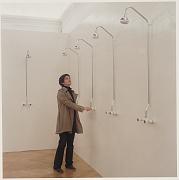Irina Nakhova
 |
 |
 |
12 SELECTED INSTALLATIONS 1994–2004
POWER SHOWER
2002
5 shower fixtures, 5 audio tracks, overall installation size 250 x 500 cm
Formally, the Shower’s white wall inflected with silver rods pays homage to the Russian Avant-Garde. But the Moscow Conceptualists had a love/hate relationship to their Avant-Garde, which in the person of Malevich set the absolutist, bullying tone that the Socialist Realists adopted in toppling them. To the late Communist artist, the Constructivists’ enthusiastic promotion of the revolution hardly recommended them. On the other hand their minimalist, geometrical forms held extraordinary artistic possibilities. Nakhova’s formal wall, however beautiful, stutters with contradictory meaning. And there is more. This is not merely a formal presentation. The silver rods are showers with actual knobs and shower heads. One of the Moscow Conceptualist Ilya Kabakov’s earliest experiments with his own artistic voice in the 1960s consisted of crude drawings in outline of a man under a shower head. This man was a late Soviet man, badly made, hapless, waiting for what came from above with no power to alter it. Kabakov made scores of these drawings in which the fate showered from above is different but always the same. In 2002, Nakhova’s shower invites - even dares - the viewer to enter in, turn the knob and take a role in causing the effect. The viewer becomes complicit in what happens next, just as audiences all over the world bear some responsibility for their mindless consumption of mixed messages exported by American pop culture and the international media. The turn of each handle produces a voice – Hitler, Lenin, Mao, Mussolini, and an Evangelical preacher of the sort that President Bush might heed. Nakhova conflates utopian programs. All utopias are suspect. The viewer, caught in this world between now and then, East and West, words and realities, the 20th century and the 21st, has a choice. The viewer can turn off the knob. We can silence the voices. For now. Turn the knob, and the voices are there again, babbling their bloody and seductive messages.
Amei Wallach, 2004